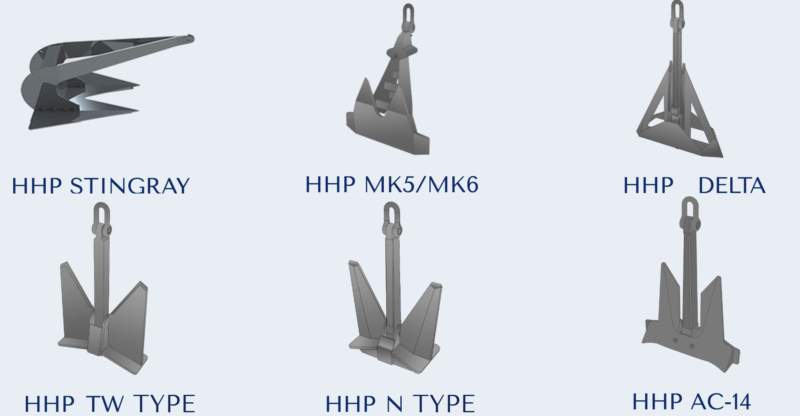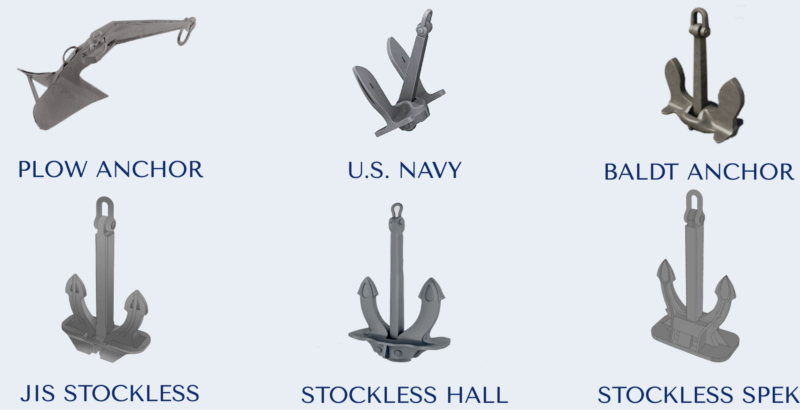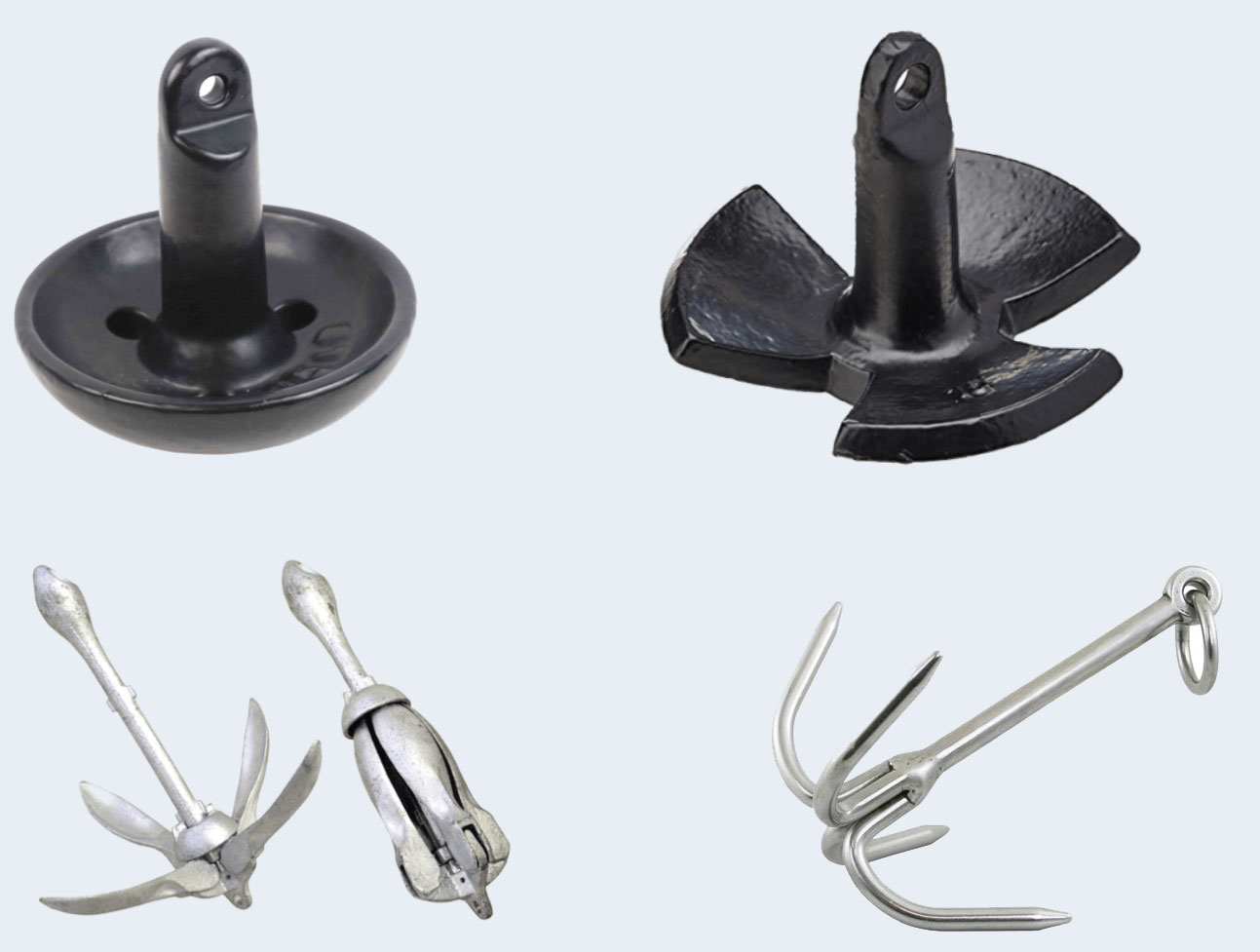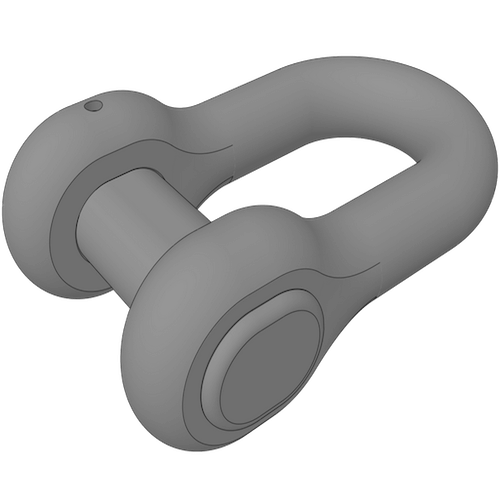MARINE ANHOR
- Pilotfits’ selection can be divided into three different types of anchors: High Holding Power Anchors, Stockless Anchors, Special Types Anchors;
- High holding power (HHP) anchor for dredging, offshore mooring, fish farm, and yachting operation. Standard or fully balanced type for your ship design. With SS316L material option or with H.D.G. finishing for your multi-purpose;
- Stockless anchor are used for various types of small boats and commercial shipping industry. JIS stockless, Speck, Hall anchors with IACS certificates.
- Special type boat anchor have various types of grapnel anchor, river anchor, folding anchor, mushroom anchor, four-fluke and three-fluke anchor;
- Ex-stock available for AC-14 anchors, Delta anchors Spek anchors, please contact our sales engineer to check availability.
- We work with IACS societies for quality control, such as DNV, LR, ABS, BV, RINA, RS, IRS, KR, NK, CCS and other Third Parties, like SGS, BIE.
- You may also interested in Marine & Offshore Chains, chock, bollard and fairlead roller.
- No matter where you take to the open water or what kind of boat you pilot, Pilotfits has the right marine anchors for every craft!
Q&A
How to choose a suitable anchor for your yacht or project?
- The type of anchors that you need depends on the kind of boat that you have, how long you want to be moored and what kind of bottom you’re going to be travelling over.
- The type of boat that you have is an important consideration in what type of anchor you have. Usually, the larger boat you have, the heavier anchor you need. Other considerations come into play, such as space as you want to store it away conveniently. There are some important factors to choose an anchor that you should consider.
Weight and Size:
The bigger boat you have then ideally the heavier and longer the anchor you need. So, the weight and size of the anchor are important in giving you the holding power you need. Generally, you’d want to select for the higher weight and the bigger size possible but you should avoid the temptation to get one which is too heavy and too big. Fortunately, as anchors increase in weight and size and there are plenty of boat anchors guides available which will be able to show you the size that you need.
Holding Power:
Holding power depends on how much your anchor is able to hold onto the bottom of the river or sea that you’re on. Generally, high holding power can keep the boat stable. And also, this can depend on many factors such as the weight and size of your anchor, as well as the type and length of anchor chain that is used. Other factors matter too, such as whether it is holding in sand or gravel etc. and the weather conditions too.
Reactivity:
Your anchor is going to be in the water for a sustained period of time, so you have to ensure that it’s resistant to any erosion that might occur. There are two ways that anchors deal with this as they will either be galvanized whereby a layer of non-reactive metal is placed upon it, or it will be painted to provide a layer from the water to the metal.
In addition to the type of boat, different seabed conditions should also be considered. To prevent drift, anchors must develop sufficient resistance in the seabed to offset wind and waves around the boat. The seabed has to be penetrated by the anchor to hold the boat in place. For example, fluke style anchors can dig into the mud and sand to perform a great hold. For rugged use, consider purchasing a grapnel anchor, which has its spikes that stick out and aim to grab onto something like a rock or other solid object for secure stopping power. Claw and plow anchors are effective at digging in anything that will be on the floor. Mushroom anchors are typically made of solid steel and are ideal for use in soft, muddy conditions. Seabed conditions can be different wherever you go, if you are going to be in the same place as the time, then it might be a good idea to check those conditions and get an anchor that would be able to match.
Types of Anchors
Given Pilotfits’s huge selection of anchors, which one should you choose? We keep stock of all the most common types of anchors for use within offshore, shipping, aquaculture, decoration, etc. Small anchors from 10 kgs up to large 40 tonnes anchors can be delivered immediately from stock. Our selection can be divided into three different types of anchors: high holding power anchors, stockless anchors, special types anchors.
High holding power anchors performance for dredging, offshore mooring, fish farm, and yachting operation. Standard or fully balanced type for your ship design. With SS316L material option or H.D.G. finishing for your multi-purposes.
Stockless anchors are used for various types of small boats and commercial shipping industry.MK5, JIS, Spek, Hall anchors with IACS certificates. We also provide stainless steel with mirror-polishing and H.D.G. anchors.
Special type ship anchors have various types of grapnel anchor, river anchor, folding anchor, mushroom anchor, four-fluke and three-fluke anchor. Can customize according to the client’s requirements.
Besides, DNV, LR, ABS, BV, RINA, RS, IRS, KR, NK and CCS certificate can be provided for our anchors. No matter where you take to the open water or what kind of boat you pilot, Pilotfits has the right marine anchors for every craft!





